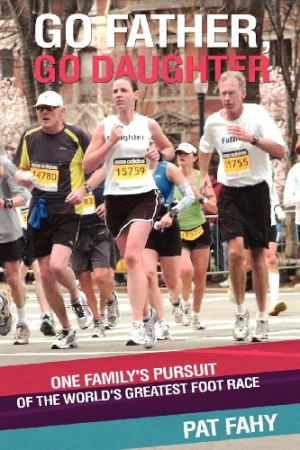Go Father, Go Daughter
One Family's Pursuit of the World's Greatest Foot Race
In Go Father, Go Daughter, Pat Fahy, a middle-aged family man, tells his personal story of setting a goal and ambitiously pursuing it. Influenced by one of his children, he decides to train to become a long-distance runner. Over the course of four years, he trains relentlessly, discovering his true passion as a marathon runner. Ultimately, he and his daughter compete together in the Boston Marathon, which he describes as “an extraordinarily special occasion that can’t possibly ever be captured again.” Fahy’s pursuit is an admirable one, and his perseverance is beyond impressive. He accomplishes exactly what he sets out to do.
Fahy writes very clearly and quite well, and his book is solidly packed with detail. Unfortunately, it is this sheer abundance of detail that makes his story cumbersome. To start, nearly fifty pages are dedicated to Fahy’s “athletic beginnings,” including information about his ten years as a USA Track and Field Masters competitor and chairman. While his background may be of interest to some, it proves to be tedious reading. Fahy provides so many specifics about prior competitions—paces, times, distances, records, averages, people, locations—that readers may find themselves completely lost or utterly bored.
Fahy’s penchant for extreme detail continues through the main part of his story. A typical description reads: “There we were, ready to do a down-and-back run on the ten-mile Rio Verde Drive segment (Dynamite Boulevard changes its name to Rio Verde Drive shortly after its intersection with Alma School Parkway) …” By including so much information that fails to add anything of substance to his story, the author derails the very best parts of what he has to say.
The true heart of Go Father, Go Daughter beats strongest when Fahy allows himself to show how he feels. After his first Boston Marathon race goes badly, and he admits that, “from every physical aspect it was a complete unmitigated disaster beyond anything I would have imagined possible,” readers will feel the depth of his disappointment. When, waiting for his daughter at the end of a different race, he worries that, “Four hours had come and gone, and with each passing moment, my concern grew exponentially … surely, she should be here by now. Could something have happened to her? … If she was still out there, certainly she must be in extreme pain.” Every parent will understand his anguish.
Sadly, the heartfelt moments of Fahy’s story are too often overwhelmed by the less significant details, and many readers, especially nonrunners, will not have the endurance to reach the end of the book.
Reviewed by
Cheryl M. Hibbard
Disclosure: This article is not an endorsement, but a review. The publisher of this book provided free copies of the book and paid a small fee to have their book reviewed by a professional reviewer. Foreword Reviews and Clarion Reviews make no guarantee that the publisher will receive a positive review. Foreword Magazine, Inc. is disclosing this in accordance with the Federal Trade Commission’s 16 CFR, Part 255.

